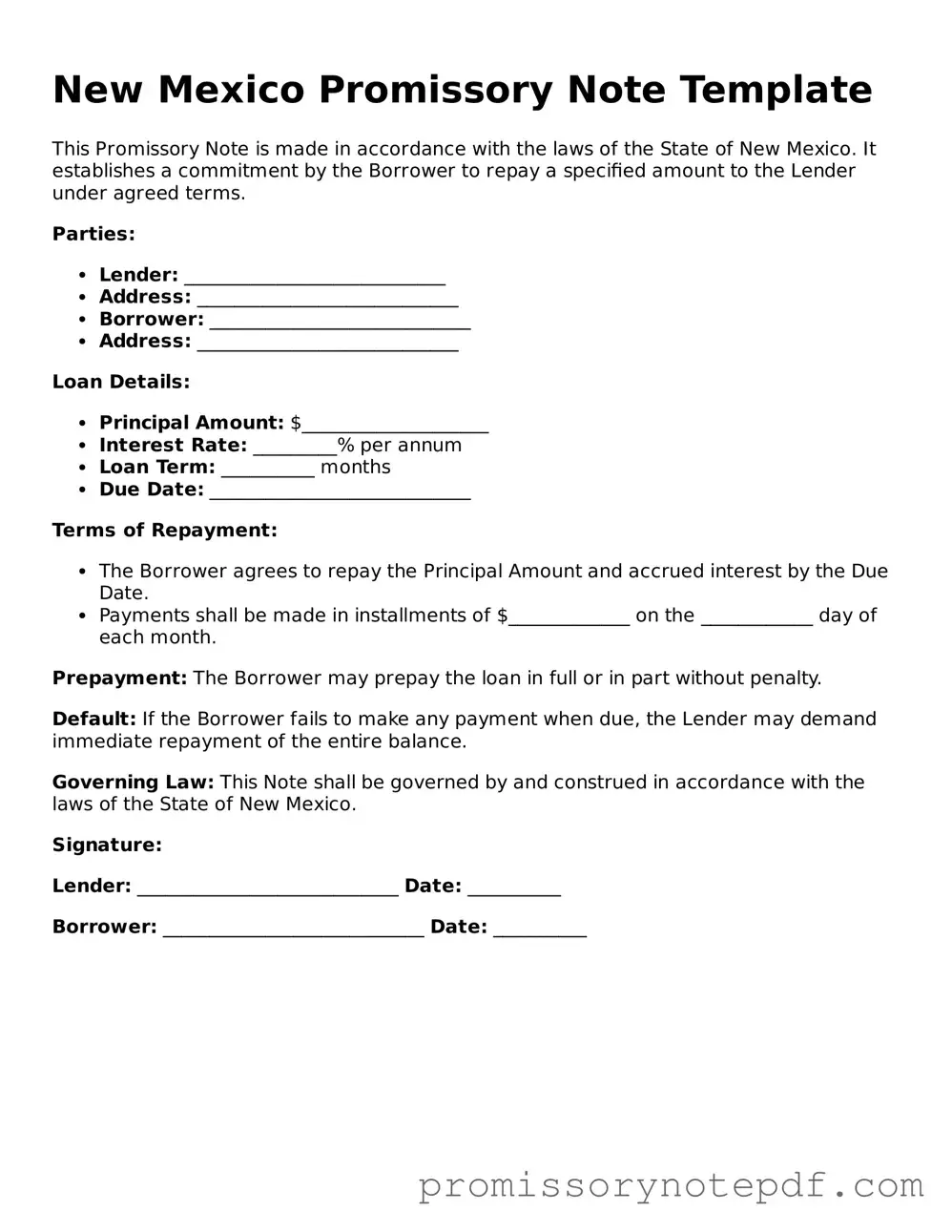The New Mexico Promissory Note form shares similarities with a Loan Agreement. Both documents outline the terms of a loan, including the principal amount, interest rate, and repayment schedule. While a Promissory Note is a simpler document focusing primarily on the borrower's promise to repay, a Loan Agreement often includes more detailed terms, such as collateral, default clauses, and other legal obligations. Both documents serve to protect the lender's interests and clarify the borrower's responsibilities.
A Security Agreement is another document that resembles the New Mexico Promissory Note. This agreement is used when a borrower pledges collateral to secure a loan. Like a Promissory Note, it establishes the borrower's obligation to repay the loan. However, the Security Agreement specifically details the collateral involved and the lender's rights to that collateral in case of default. Both documents work together to ensure the lender has recourse if the borrower fails to meet their obligations.
The Demand Note is similar to the New Mexico Promissory Note in that it requires repayment upon the lender's request. While a standard Promissory Note typically has a set repayment schedule, a Demand Note does not. Instead, it allows the lender to demand repayment at any time. This flexibility can be advantageous for lenders, but it also places more pressure on borrowers, as they must be prepared to repay the loan on short notice.
A Balloon Note also bears resemblance to the New Mexico Promissory Note. This type of note involves smaller periodic payments followed by a large final payment, known as the balloon payment. Like a Promissory Note, it specifies the terms of repayment, but the structure of payments differs significantly. Borrowers should be aware of the balloon payment, as it can require a significant financial commitment at the end of the loan term.
A Mortgage Note is another document that is closely related to the New Mexico Promissory Note. While both documents outline the borrower's promise to repay a loan, a Mortgage Note is specifically tied to real estate transactions. It includes terms for repayment and often references a mortgage or deed of trust that secures the loan with the property itself. Both documents protect the lender's interests, but the Mortgage Note adds a layer of security through the property collateral.
An Installment Note is akin to the New Mexico Promissory Note in that it outlines a repayment plan through regular installments. Both documents specify the loan amount, interest rate, and payment schedule. The primary difference lies in the structure of payments; an Installment Note may require equal payments over the loan term, making budgeting easier for borrowers. This predictability can be beneficial for both parties involved.
A Guaranty Agreement also shares similarities with the New Mexico Promissory Note. In this case, a third party agrees to take responsibility for the loan if the primary borrower defaults. While the Promissory Note establishes the borrower's obligation, the Guaranty Agreement adds an additional layer of security for the lender. Both documents work together to ensure that the lender has multiple avenues for recourse in case of non-payment.
A Line of Credit Agreement is similar to a Promissory Note in that it outlines the terms of borrowing. However, a Line of Credit allows borrowers to withdraw funds up to a certain limit as needed, rather than receiving a lump sum upfront. Both documents specify interest rates and repayment terms, but the flexibility of a Line of Credit can be advantageous for borrowers who require access to funds over time.
A Conditional Sales Agreement is also comparable to the New Mexico Promissory Note. This document outlines the terms under which a buyer agrees to purchase an item, typically with financing involved. Like a Promissory Note, it includes payment terms and conditions. However, a Conditional Sales Agreement often allows the seller to retain ownership of the item until the buyer fulfills all payment obligations, adding a layer of protection for the seller.
Finally, a Lease Agreement can be seen as similar to the New Mexico Promissory Note, particularly in cases where a lease involves installment payments. Both documents set forth the terms of payment and obligations of the parties involved. However, a Lease Agreement typically pertains to the rental of property rather than a loan, and it may include additional terms regarding the use of the property and responsibilities for maintenance.
